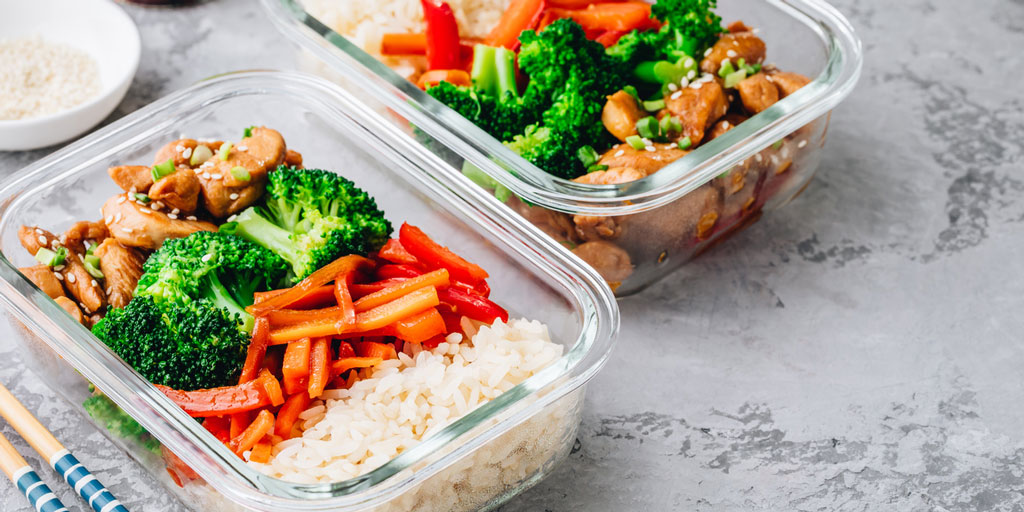Get started with a free trial.
10 FRIDGE ESSENTIALS FOR HEALTHY MEAL PREP
Filling your fridge with healthy perishables makes whipping up nutritious meals a pleasure, not a chore. Top up your fridge with these 10 versatile ingredients.
1. FRESH FRUIT
Always choose in-season varieties. Not only is it more nutritious, it’s way cheaper. Spend five minutes a few times a week to chop or slice fruit and store in clear containers so it catches your eye when you need quick snack on the fly.
2. READY-TO-EAT PROTEIN
For those days when don’t have time to make a meal from scratch, having a fridge of ready-to-eat protein will quell hunger without resorting to unhealthy snacking or dialling takeaway. Pre-cook quinoa, chicken breast or smoked salmon and can be used to make a lunch salad. Fish like salmon also cook fast if you are looking for a fresh high-protein dinner option. A carton of free-range eggs make opting for a healthy, protein-filled breakfast an easy choice.
3. VEGETABLES
Always have a few snackable veggies on hand for when you’re craving something crunchy and savoury. Baby carrots, celery, sliced capsicum and cucumber can be eaten on their own or with a healthy dip, such as hummus, avocado or pesto. Consider single-serve bags of baby spinach, rocket or kale a shopping-list staple. It’s easy to pair leafy greens with lunch or dinner, or make it into a standalone meal by adding a small portion of grilled chicken or lean steak, sliced. Include healthy carbs such as sweet potato and pumpkin and load up on zucchinis, which can be grated into omelettes, frittatas dish or spiralised into ‘pasta’.
4. FRESH HERBS
Fresh herbs add flavour and freshness to almost any recipe Your go-to staples include parsley, thyme, coriander or mint To extend their shelf-life, wrap them in a damp paper towel before storing.
5. GREEK YOGHURT
On average, Greek yoghurt has twice the amount of protein found in regular yoghurt and can be used as a healthy swap for sour cream on tacos, salad dressings or a sweet alternative to ice cream, topped with fresh fruit for dessert.
6. HOMMUS
Keep a tub on hand for a high-protein snack alternative to slabs of cheese or a fistful of potato chips. Better still, whip up your own by placing a can of chickpeas, 2 tablespoons of tahini, two garlic cloves and quarter cup of extra virgin olive oil and blend in a food processor. Too easy!
7. CHEESE
Whether it’s feta, mozzarella, ricotta or cheddar, halloumi, if you’re into cooking or snacking with cheese, then this collection is for you. Team ricotta with fruit and toast for breakfast, grilled halloumi is delicious in salads, top wholegrain crackers with sliced cheddar and top homemade pizza with feta or mozzarella
8. MILK OR MILK ALTERNATIVES
Milk ticks all the post-workout nutritional boxes. It contains carbohydrates to help top up muscle glycogen stores, quality protein to aid muscle repair and calcium and electrolytes to optimise hydration. Mix milk into your morning muesli, add to smoothies, or drink up as a post-workout help replenish fatigued muscles. Not into cow’s milk? Plant-based varieties, such as soy, almond, or rice milk have grown in popularity and can be used to replace milk or any dish that requires a creamy texture. Opt for calcium-enriched where possible.
9. FROZEN VEGETABLES
Keeping a bag or individual serves of frozen vegetables in the freezer allows for a ready-to-go choice on any given night – especially when do not have the time to make multiple trips to the supermarket each week. Not only avoid excess food waste, but also you’re still getting as many nutrients (if not more) as their fresh counterparts. Corn, cauliflower, broccoli, edamame, or green beans are versatile staples. Just be careful not to overcook so to retain their crispiness.
10. FROZEN FRUIT
Just like frozen veggies, frozen fruit is both a nutritious and versatile ingredient, especially when their fresh counterpart is not in season. They work well in smoothies, pancakes, baked goods like muffins or sweet potato brownies or skewers. Think mixed berries, bananas, or pineapples.

Filter
Show by